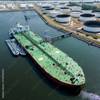Global LPG Prices Decline: Dorian LPG
The biggest market change in the fourth calendar quarter of 2018, was the decline in crude oil prices, with Brent falling from a monthly average of nearly $82/barrel in October, finishing the year below $51 per barrel. As a result, global liquefied petroleum gas (LPG)prices followed the downward trend.
Dorian LPG, the Stamford-based owner and operator of 22 very-large gas carriers, said that without the additional LPG cargoes out of Marcus Hook from Mariner East 2, which started operations in January 2019, U.S. exports remained similar to the third calendar quarter of 2018, if not slightly lower.
Total LPG exports from the U.S. are estimated at 32.8 million metric tons for the full year, up nearly 10% year-over-year. Middle Eastern volumes were also relatively unchanged quarter on quarter at around 10 million metric tons, with Asia remaining the key outlet.
In terms of direction of trade, one of the major changes we observed in the fourth calendar quarter, was an increase VLGC cargoes from the U.S. Gulf Coast to NW Europe and the Mediterranean compared to the previous quarter, with less volume heading East as a result.
Economics for utilizing propane in steam crackers within the European landscape were favorable with the propane-naphtha spread widening from an average of approximately $72 per metric ton in the third calendar quarter 2018 to approximately $86 per metric ton in the fourth calendar quarter of 2018.
After a relatively strong third calendar quarter of 2018, Chinese demand dipped towards the end of the year, albeit still showing an increase of nearly 1 million metric tons for the entire calendar year of 2018 versus 2017. Propane dehydrogenation (PDH) margins have remained favorable in 2018 in Asia resulting in good operating rates and continued demand into this sector.
PDH demand is expected to grow further in 2019 with increased propane demand from new PDH facilities in China. Other Far Eastern importers showed strong demand in the fourth calendar quarter of 2018, but a mild winter thus far has recently limited import demand.
The Baltic VLGC Index peaked in the fourth calendar quarter, averaging $46 per metric ton on average in October 2018, The Baltic Index subsided in the remainder of the fourth calendar quarter ending December at an average of just over $38 per metric ton. This overall gives an average of around $34.5 per metric ton for 2018, stronger than the sub $28 per metric ton on average in 2017.
The VLGC orderbook stands at around 14% of the current global fleet. An additional 38 VLGCs, equivalent to around 3.1 million cbm of carrying capacity, will be added to the global fleet by calendar year-end 2021. The average age of the global fleet is now approximately nine years old.
Liquefied gases are primarily used for industrial and domestic heating, as a chemical and refinery feedstock, as a transportation fuel and in agriculture. The LPG shipping market historically has been stronger in the spring and summer months in anticipation of increased consumption of propane and butane for heating during the winter months. In addition, unpredictable weather patterns in these months tend to disrupt vessel scheduling and the supply of certain commodities.














